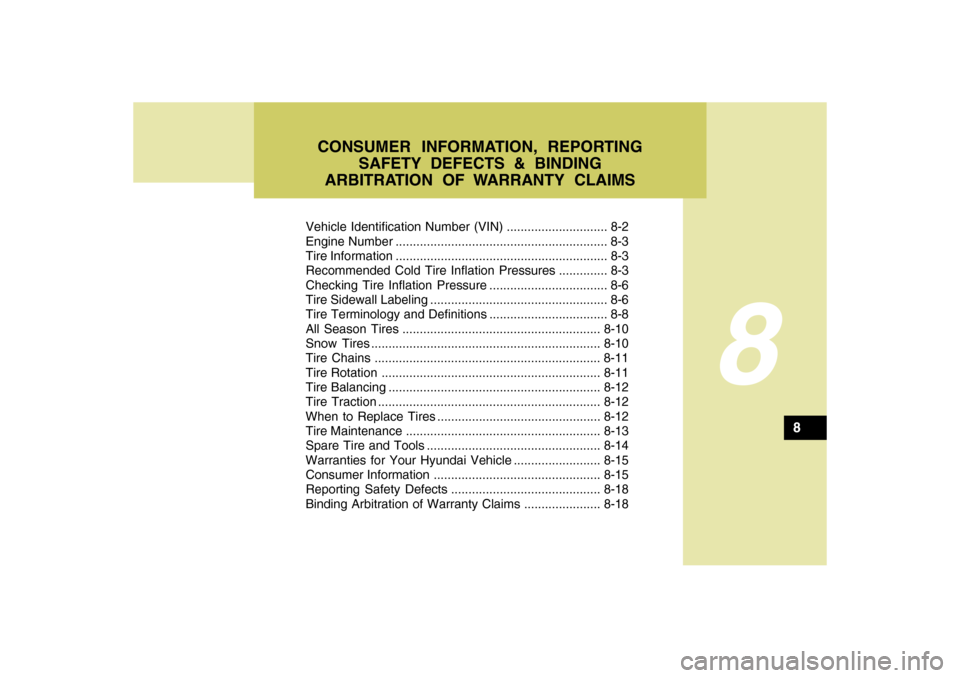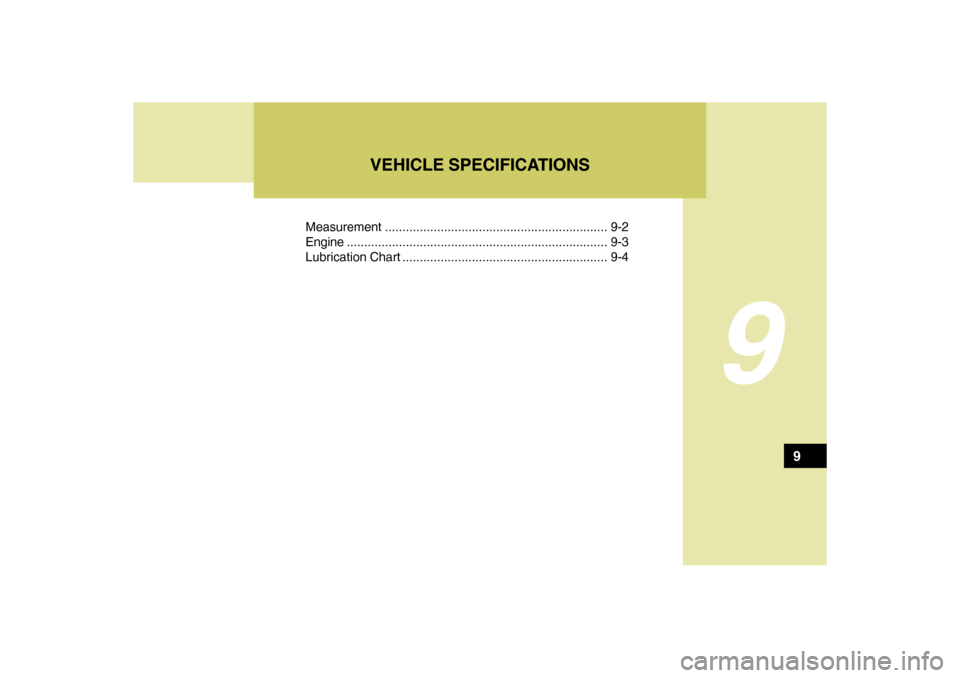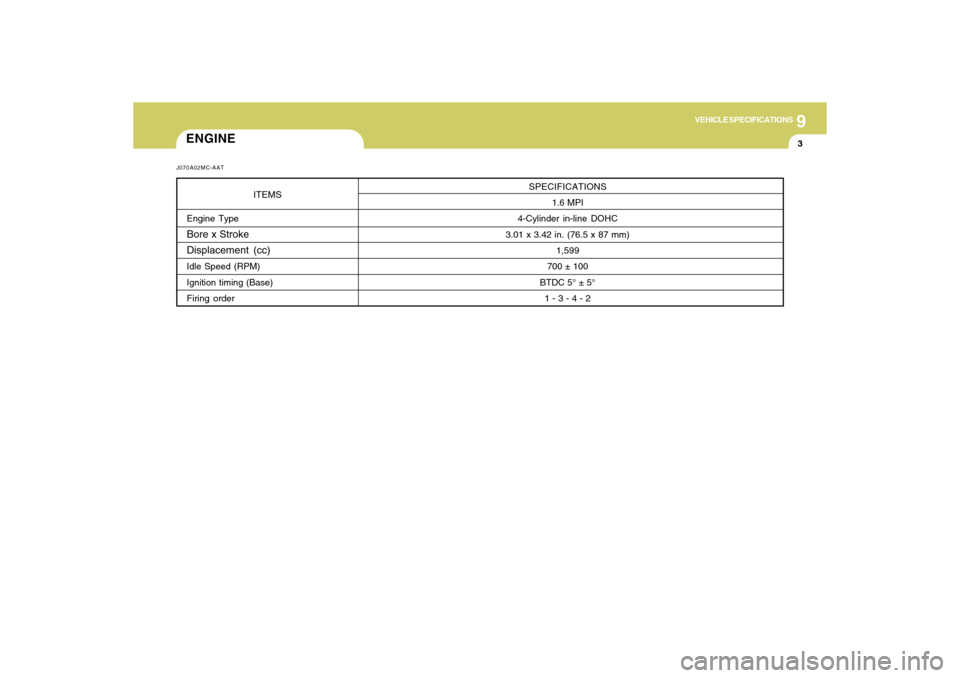2009 Hyundai Accent engine
[x] Cancel search: enginePage 237 of 266

7
EMISSION CONTROL SYSTEMS2
EMISSION CONTROL SYSTEM
CanisterFuel vapors generated inside the fuel
tank are absorbed and stored in the
onboard canister. When the engine is
running, the fuel vapors absorbed in the
canister are drawn into the induction sys-
tem through the purge control solenoid
valve.Purge Control Solenoid Valve (PCSV)The purge control solenoid valve is con-
trolled by the Engine Control Module
(ECM); when the engine coolant tem-
perature is low during idling, the PCSV
closes so that evaporated fuel is not taken
into the engine. After the engine warms-
up during ordinary driving, the PCSV
opens to introduce evaporated fuel to the
engine.
H010B01A-AAT1. Crankcase Emission Control
SystemThe positive crankcase ventilation sys-
tem is employed to prevent air pollution
caused by blow-by gases being emitted
from the crankcase. This system supplies
filtered fresh air to the crankcase through
the air intake hose. Inside the crankcase,
the fresh air mixes with blow-by gases,
then passes through the PCV valve into
the induction system.
H010A01A-AATYour Hyundai is equipped with an emis-
sion control system to meet all require-
ments of the U.S. Environmental Protec-
tion Agency or California Air Resources
Board.
There are three emission control systems
which are as follows.
1) Crankcase Emission Control System
2) Evaporative Emission Control System
3) Exhaust Emission Control System
In order to ensure the proper function of
the emission control systems, it is recom-
mended that you have your car inspected
and maintained by an authorized Hyundai
dealer in accordance with the mainte-
nance schedule in this manual.
H010D01A-AAT3. Exhaust Emission
Control SystemThe Exhaust Emission Control System is
a highly effective system which controls
exhaust emissions while maintaining
good vehicle performace.
H010C01S-AAT2. Evaporative Emission Control (In-
cluding ORVR: Onboard Refuel-
ing Vapor Recovery) SystemThe Evaporative Emission Control Sys-
tem is designed to prevent fuel vapors
from escaping into the atmosphere.
(The ORVR system is designed to allow
the vapors from the fuel tank to be loaded
into a canister while refueling at the gas
station, preventing the escape of fuel
vapors into the atmosphere.)
Page 238 of 266

7
EMISSION CONTROL SYSTEMS
3
CATALYTIC CONVERTER
!
!
H020A03A-AAT(If Installed)Hyundai vehicle is equipped with a mono-
lith type three-way catalytic converter to
reduce the carbon monoxide, hydrocar-
bons and nitrogen oxides contained in
the exhaust gas. Exhaust gases passing
through the catalytic converter cause it to
operate at a very high temperature. The
introduction of large amounts of unburned
gasoline into the exhaust may cause the
catalytic converter to overheat and create
a fire hazard. This risk may be reduced by
observing the following:WARNING:
o Do not touch the catalytic converter
or any other part of the exhaust sys-
tem while the catalytic converter is
hot. Shut off the engine, wait for at
least one hour before touching the
catalytic converter or any other part
of the exhaust system.
o Remember that your Hyundai dealer
is your best source of assistance.
o Do not park, idle or drive your ve-
hicle over any combustible material
such as grass, paper, leaves or rags.
These materials might contact the
hot catalytic converter and a fire
might result.
H020A01MC
Catalytic Converter
WARNING:
o Use unleaded fuel only.
o Maintain the engine in good operat-
ing condition. Extremely high cata-
lytic converter temperatures can re-
sult from improper operation of the
electrical, ignition or multiport elec-
tronic fuel injection.
o If your engine stalls, pings, knocks,
or is hard to start, have your Hyundai
dealer inspect and repair the prob-
lem as soon as possible.
o Avoid driving with a very low fuel
level. Running out of gasoline may
cause the engine to misfire and re-
sult in damage to the catalytic con-
verter.
o Avoid idling the engine for periods
longer than 10 minutes.
o The vehicle should not be pushed or
pulled to get started. This may cause
the catalytic converter to overheat
and create a fire hazard.
Page 239 of 266

CONSUMER INFORMATION, REPORTING
SAFETY DEFECTS & BINDING
ARBITRATION OF WARRANTY CLAIMS
Vehicle Identification Number (VIN) ............................. 8-2
Engine Number ............................................................. 8-3
Tire Information ............................................................. 8-3
Recommended Cold Tire Inflation Pressures .............. 8-3
Checking Tire Inflation Pressure .................................. 8-6
Tire Sidewall Labeling ................................................... 8-6
Tire Terminology and Definitions .................................. 8-8
All Season Tires .........................................................8-10
Snow Tires..................................................................8-10
Tire Chains ................................................................. 8-11
Tire Rotation ...............................................................8-11
Tire Balancing.............................................................8-12
Tire Traction................................................................8-12
When to Replace Tires ...............................................8-12
Tire Maintenance........................................................8-13
Spare Tire and Tools..................................................8-14
Warranties for Your Hyundai Vehicle.........................8-15
Consumer Information................................................8-15
Reporting Safety Defects ...........................................8-18
Binding Arbitration of Warranty Claims...................... 8-18
8
8
Page 241 of 266

8
CONSUMER INFORMATION, REPORTING SAFETY DEFECTS & BINDING ARBITRATION OF WARRANTY CLAIMS
3
ENGINE NUMBERI010B01A-AATThe engine number is stamped on the
engine block as shown in the drawing.
TIRESI020A02A-AATTIRE INFORMATION
The tires supplied on your new Hyndai
are chosen to provide the best perfor-
mance for normal driving.
If you ever have questions about your
tire warranty and where to obtain ser-
vice, see the tire manufacture's book-
let included with your vehicle's Owner's
Manual Literature Kit.
I030A02MC-AATRECOMMENDED COLD TIRE INFLA-
TION PRESSURES
Tire label located on the driver's side
of the center pillar outer panel gives
the cold tire pressures recommended
for your vehicle with the original tire
size, the number of people that can be
in your vehicle and vehicle capacity
weight.
OMC079012
OMC065001
Page 257 of 266

Measurement ................................................................ 9-2
Engine...........................................................................9-3
Lubrication Chart ........................................................... 9-4
VEHICLE SPECIFICATIONS
9
9
Page 259 of 266

9
VEHICLE SPECIFICATIONS
3
ENGINE
SPECIFICATIONS
1.6 MPI
4-Cylinder in-line DOHC
3.01 x 3.42 in. (76.5 x 87 mm)
1,599
700 ± 100
BTDC 5° ± 5°
1 - 3 - 4 - 2
J070A02MC-AAT
ITEMS
Engine Type
Bore x Stroke
Displacement (cc)Idle Speed (RPM)
Ignition timing (Base)
Firing order
Page 260 of 266

9
VEHICLE SPECIFICATIONS4
Oil & Grease Standard
API SJ, SL or ABOVE,
ILSAC GF-3 or ABOVE
HYUNDAI GENUINE PARTS MTF 75W/85 (API GL-4)
HYUNDAI GENUINE ATF SP III, DIAMOND ATF SP III, SK ATF SP III or other
brands meeting the SP III specification approved by Hyundai Motor Co.PSF-3
DOT 3, DOT 4 or Equivalent
Ethylene glycol base for aluminum radiatorSAE 5W-20, 5W-30
(ALL TEMP. RANGE)
SAE 10W-30 [ABOVE 0°F (-18°C)]
LUBRICATION CHART
Item
Engine oil
Recommends
TransaxleManual
Automatic
Power steering
Brake fluid
CoolantManual
Transaxle
Automatic
Transaxle
J080A01MC-AAT
Q'ty (US.QTS)(Imp.qts, liter)
Drain and refill
Without oil filter : 3.17 (2.6, 3.0)
With oil filter : 3.48 (2.9, 3.3)
2 (1.67, 1.9)
6.44 (5.3, 6.1)
As required
As required
5.49 (4.5, 5.2)
5.60 (4.6, 5.3)
Page 263 of 266

10
INDEX
3
D
Defrosting/Defogging........................................... 1-112, 1-115
Door
Central door locks ............................................................ 1-7
Door locks ......................................................................... 1-4
Door ajar warning light and chime ................................1-66
Locking and unlocking front door with a key .................. 1-5
Drink Holder .......................................................................1-84
Driving
Economical driving .........................................................2-15
Smooth cornering ...........................................................2-16
Winter driving ..................................................................2-16
E
Emission Control System ..................................................... 7-2
Engine
Before starting the engine ................................................ 2-3
Compartment.................................................................... 6-2
Coolant .............................................................................. 6-7
If the engine overheats ..................................................... 3-4
Number............................................................................. 8-3
Oil ...................................................................................... 6-4
Starting.............................................................................. 2-5
Engine Exhaust Can Be Dangerous! .................................. 2-2F
Fog Light
Front ................................................................................1-82
Front Seats
Adjusting seat forward and rearward ............................1-14
Adjusting seatback angle ...............................................1-15
Headrest..........................................................................1-15
Seat cushion height adjustment ................................... 1-17
Fuel
Capacity............................................................................ 9-2
Gauge..............................................................................1-70
Recommendations............................................................ 1-2
Fuel Filler Lid
Remote release ..............................................................1-94
Fuse Panel Description .....................................................6-28
Fuses..................................................................................6-16
G
General Checks ................................................................... 6-3
Glove Box ...........................................................................1-88
H
Hazard Warning System ....................................................1-81
Headlight
Replacement...................................................................6-22
Switch..............................................................................1-76